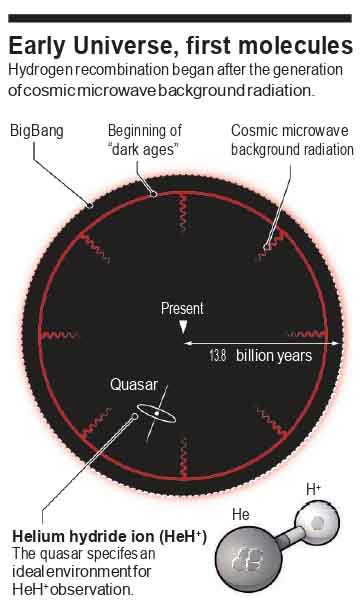
Concepción, 20 August 2019
Early Universe and its chemistry: new ideas and observation paths
Astonishing discovery for the astrochemistry world was unveiled this april: The presumably detection of the first molecular bind in the Universe. The helium hydride ion HeH+ was detected in the planetary nebula NGC 7027, confirming chemical predictions that essentially explains the Universe as we know it possible.
In august, Novotny et al. published “Quantum-state-selective electron recombination studies suggest enhanced abundance of primordial HeH+” in the journal Science. Dr. Stefano Bovino, an academic at the Astronomy Department, who was invited by Science to comment on the article, explained: "the destruction rate for HeH+ by collisions with electrons was measured. This is the most important destruction process for this molecule; in fact, it determines its abundance and observability. The experiment also represents an step forward for studies of this kind, that is, ionic molecules with electrons, which can be now applied to other molecules relevant to astrophysics".
Dr. Bovino specialises in astrocemistry and focuses on state-of-the-art models to allow comparison and a better interpretation of observational data. As astrochemist, he is involved in several different problems where microphysics is relevant, for instance, the interestellar medium in galaxies, star formation in molecular clouds, and the transition between Popullation III and II stars including the early universe's chemistry. "During my PhD I conducted studies related to HeH+. In an article of 2011, using new theoretycal calculations we combined quantum chemistry and astrochemical models, where we showed that HeH+ abundance is higher than expected from previous studies", explained Dr. Bovino.
These results generated renewed interests in this topic, where it was cited by other researchers in prestigous journals such as Nature and Science. Because of this, the journal Science invited him to comment the article "Quantum-state-selective electron recombination studies suggest enhanced abundance of primirdial HeH+".
The analysis by Drs. Stefano Bovino and Danielle Galli is titled “First molecule still animates astronomers. A study of the helium hydride ion stirs up primordial astrochemistry”. Dr. Bovino states: "Basically, in our article we comment the new articles: HeH+ observations by Rolf Güsten and collaborators and the new experiment by Novotny et al. considering the general context".
The article explains why these new studies are important for the field. "In fact, we have observed HeH+ in a planetary nebula, a hot environment where ionised hydrogen is present and HeH+ can form. However, ideally, we would like to observe HeH+ in a quasar, that is, the active nucleus of a distant galaxy in order to test theoretical predictions about the history of the Universe."
These results have open a new path for the observation of this molecule. "For example, we could observe the effect of this particle over the cosmic microwave background, because photons emitted from primordial molecules can interact with the cosmic background radiation, which generate spectral fluctuactions.", concludes the academic.
To read the analysis by the Drs. Bovino and Galli over Novotny et al. article, visit the link: https://science.sciencemag.org/content/365/6454/639/tab-pdf
To read Novotny et al., article, visit the link: https://science.sciencemag.org/content/365/6454/676.abstract
To read about the first observation, visit the link: https://www.nature.com/articles/s41586-019-1090-x
Celeste Burgos BadalAstronomy Department Communications




